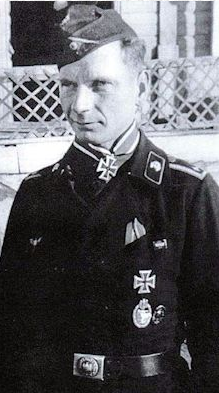Banach, Friedrich
- Date of birth:
- January 2nd, 1916 (Rotthausen-Gelsenkirchen/Western Phalia, Germany)
- Date of death:
- March 13th, 1943 (Zaporizhia/Zaporizhia Oblast, near Slawgorod, Ukraine)
- Buried on:
- German War Cemetery Kharkiv
- Nationality:
- German
Biography
Last achieved rank was Oberfeldwebel.
From October 1, 1936 to October 23, 1937, he did his labor service at RAD Department 3/208 in Felbecke, where he was dismissed as head foreman.
On November 3rd, 1937, Banach joined the 7th Company of the 5th Panzer Regiment in Wünsdorf as a volunteer. Promoted to private on October 1, 1938, he was transferred to the 4th Company of Panzer Regiment 36 in Schweinfurt on November 10, 1938.
Banach had participated in the operation in the Sudetenland and Czechoslovakia and went to the Poland campaign on September 1st, 1939.
After the end of the fighting he was promoted to NCO on October 1, 1939 and was given a vacation to Witten / Ruhr until October 31, 1939.
On his return he took part in the campaign in France and then in the Balkans.
In the meantime he had been treated for varicose veins on January 18, 1941 in the Schweinfurt reserve hospital.
After the start of the Eastern campaign, Banach was promoted to Sergeant on October 1, 1941 and took part in the attack battles in the south of the Eastern Front as part of the 14th Panzer Division.
From the summer of 1942 he took part in the attack of the 6th Army in the direction of Stalingrad. On August 7th, 1942 he was wounded eight kilometers southwest of Tinguta off Stalingrad by a shrapnel under his right and left eyes.
If the division fights between 25.11. and on December 15, 1942, during the attack on a Soviet cavalry division, Banach took the lead of a platoon of his regiment that had become leaderless. He then worked his way to the left flank of the enemy, skilfully exploiting the terrain, and shot down five enemy chariots there, which made life difficult for the company attacking from the front. Without waiting for the support of other chariots of his platoon, Banach pushed on, shot down a scout car and broke into the opponent's hawser, which was moving close together, causing utter panic. In doing so, Banach contributed to the success of his department's attack. To date, Banach had destroyed 43 tanks and numerous artillery pieces. He was also proposed for the Knight's Cross, which was awarded to him on November 30, 1942.
The handover took place on December 17th, 1942 by Colonel I.G. Doerr, chief of the liaison staff to the 4th Royal Hungarian Army. At that time, Banach was no longer in the Stalingrad pocket.
However, when he left the cauldron is unknown.
At least he must have been in the boiler on November 25, 1942.
The promotion to sergeant major took place on December 1st, 1942.
Since the Knight's Cross was awarded to Sergeant Banach, the act probably took place between November 25th. and 01.12.1942.
From December 24th, 1942 to January 14th, 1943 he was given vacation leave and then returned to the front.
There he was killed on February 23, 1943 in the fighting near Hauptsh Zaporozhye in the Slavgorod / Donetsk area.
Banach was among other things also RAD Unterfeldmeister in Arbeitsgau XX, Westphalia South.
Do you have more information about this person? Inform us!
- Period:
- Second World War (1939-1945)
- Awarded on:
- November 4th, 1939
- Period:
- Second World War (1939-1945)
- Awarded on:
- September 30th, 1940
- Period:
- Second World War (1939-1945)
- Rank:
- Feldwebel (Staff Sergeant)
- Unit:
- 4. Kompanie, Panzer-Regiment 36, 14. Panzer-Division
- Awarded on:
- November 24th, 1942
- Period:
- Second World War (1939-1945)
- Rank:
- Feldwebel der Reserve
- Unit:
- Zugführer, 4. Kompanie, Panzer-Regiment 36, 14.Panzer-Division, 6.Armee, Heeresgruppe Don
- Awarded on:
- November 30th, 1942
Up to this time Banach had destroyed 43 Soviet tanks as well as numerous guns of all kinds. He would thusly be awarded the Knight’s Cross for both this major tactical victory and his cumulative successes to date.
- Period:
- Second World War (1939-1945)
- Period:
- Second World War (1939-1945)
- Awarded on:
- August 14th, 1942
- Period:
- Second World War (1939-1945)
- Awarded on:
- August 17th, 1942
- Period:
- Second World War (1939-1945)
- Awarded on:
- May 18th, 1940
Sources
- Photo 1:
- - WEGMANN, GüNTER, Die Ritterkreuzträger der Deutschen Wehrmacht 1939-1945, Biblio-Verlag, 2004.
- Die Ordensträger der Deutschen Wehrmacht (CD), VMD-Verlag GmbH, Osnabrück, 2002
- Fellgiebel W.P., Elite of the Third Reich, The recipients of the Knight's Cross of the Iron Cross 1939-1945: A Reference, Helion & Company Limited, Solihull, 2003, ISBN 1-874622-46-9
- Federl, C., Die Ritterkreuzträger der Deutschen Panzerdivisionen 1939-1945, VDM Heinz Nickel, Zweibrücken, Germany, 2000
- Patzwall K., Scherzer V., Das Deutsche Kreuz 1941-1945, Geschichte und Inhaber Band II, Verlag Klaus D. Patzwall, Norderstedt, 2001
- Knight's Cross Certificate for Friedrich Banach










